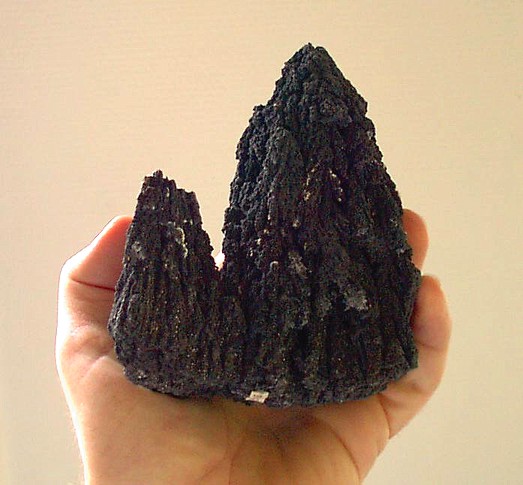ARSENIC
History
Arsenic, a unique element on the periodic table, was first mined by the early Chinese, Greek and Egyptian civilizations. There is no doubt that they discovered the toxic properties of Arsenic. Many years later in 1250 A.D., it is believed that Albertus Magnus obtained the element by heating soap together with orpiment. This pro duces arsenic trisulphide (As2S3). In fact, the word Arsenic is derived from the Greek word "Arsenikon", which means "yellow orpiment".
duces arsenic trisulphide (As2S3). In fact, the word Arsenic is derived from the Greek word "Arsenikon", which means "yellow orpiment".
Arsenic, a unique element on the periodic table, was first mined by the early Chinese, Greek and Egyptian civilizations. There is no doubt that they discovered the toxic properties of Arsenic. Many years later in 1250 A.D., it is believed that Albertus Magnus obtained the element by heating soap together with orpiment. This pro
 duces arsenic trisulphide (As2S3). In fact, the word Arsenic is derived from the Greek word "Arsenikon", which means "yellow orpiment".
duces arsenic trisulphide (As2S3). In fact, the word Arsenic is derived from the Greek word "Arsenikon", which means "yellow orpiment".Arsenic and You
How does Arsenic effect your life? If all you know about Arsenic is that it is toxic, then you are probably hoping it has nothing to do with you at all. But did you know that you have arsenic in your body right now? In fact everyone does. Someone who weighs around 150 lbs has about 0.003405 grams of Arsenic in their body at any given time. A level of 0.00001% is needed for growth and for a healthy nervous system.An Arsenic deficiency results in inhibited growth in humans.
http://www.webelements.com/arsenic/biology.html (arsenic calculator)
http://www.webelements.com/arsenic/biology.html (arsenic calculator)
How Safe is Arsenic
Humans mainly acquire Arsenic through food and water. Food is usually the largest source except in areas where drinking water is naturally contaminated with arsenic. Long-term ingestion of arsenic, mainly from drinking of contaminated well water, can be harmful. In Taiwan, it has caused a disease called the “blackfoot disease”, in which the blood vessels of the leg and foot become damaged, resulting in coldness, loss of feeling. As you can see, Arsenic and its compounds can be quite toxic. Our bodies do not readily absorb the element itself, hence pure arsenic is much less dangerous than As(III) compounds which are absorbed easily and are carcinogenic with high toxicity. 
Arsenic is immediately dangerous to life or health at 5 mg m-3. Large amounts of Arsenic causes rapid poisoni ng or even death. Long-term exposure to high levels of arsenic in drinking water can cause thickening and pigment spots in the skin, and cancer of the skin, lungs, bladder or kidney. Those who smoke cigarettes or who inhale smoke from cigarettes are at greater risk for these health problems because Arsenic is one of the hundreds of poisonous substances in cigarettes.
ng or even death. Long-term exposure to high levels of arsenic in drinking water can cause thickening and pigment spots in the skin, and cancer of the skin, lungs, bladder or kidney. Those who smoke cigarettes or who inhale smoke from cigarettes are at greater risk for these health problems because Arsenic is one of the hundreds of poisonous substances in cigarettes.
Arsenic is immediately dangerous to life or health at 5 mg m-3. Large amounts of Arsenic causes rapid poisoni
 ng or even death. Long-term exposure to high levels of arsenic in drinking water can cause thickening and pigment spots in the skin, and cancer of the skin, lungs, bladder or kidney. Those who smoke cigarettes or who inhale smoke from cigarettes are at greater risk for these health problems because Arsenic is one of the hundreds of poisonous substances in cigarettes.
ng or even death. Long-term exposure to high levels of arsenic in drinking water can cause thickening and pigment spots in the skin, and cancer of the skin, lungs, bladder or kidney. Those who smoke cigarettes or who inhale smoke from cigarettes are at greater risk for these health problems because Arsenic is one of the hundreds of poisonous substances in cigarettes.Characteristics
Arsenic is a steel grey, very brittle, crystalline, semi metallic solid. It comes in 3 forms: gray, yellow, and black arsenic. Gray arsenic is the most common. It has a metallic sheen and conducts electricity. Yellow arsenic is a poor electrical conductor and does not have a metallic sheen. It is prepared by cooling gray arsenic vapor in liquid air. It reverts to gray arsenic at room temperature. Black arsenic can be prepared by cooling arsenic vapor at 100 oC - 200 oC. It is glassy, brittle and a poor electrical conductor.


 (Grey, Yellow, and Black Arsenic)
(Grey, Yellow, and Black Arsenic)Reactivity
Arsenic tarnishes in the air. When heated rapidly, Arsenic oxidizes to Arsenous oxide which has a garlic odor. One special characteristic of Arsenic is that when it is heated, it sublimes, which means it goes straight from a solid to a gas, skipping the liquid state. Also, Arsenic is stable in dry air, but the surface oxidizes slowly in moist air to give a bronze tarnish and finally a black covering to the element. What you may not know about Arsenic is that it reacts with other elements. Arsenic reacts with fluorine, F2, to form the gas Pentafluoride arsenic(V) fluoride.
Arsenic is found in nature in a number of minerals including Realgar (As4S4), Orpiment (As2S3), Arsenolite (As2O3), and iron minerals such as Arsenopyrite (FeAsS) and Loellingite (FeAs2).
Arsenic is found in nature in a number of minerals including Realgar (As4S4), Orpiment (As2S3), Arsenolite (As2O3), and iron minerals such as Arsenopyrite (FeAsS) and Loellingite (FeAs2).
Where is Arsenic Found?
Arsenic is most commonly found in France, Germany, Italy, Romania, Siberia, and North America. More specifically, Arsenic is found in food and water, typically well water. However it is also found in the environment. In air, levels are lowest in remote and rural areas, higher in urban areas, and highest close to industrial sources. In water, levels of arsenic are lowest in seawater, higher in rivers and  lakes and highest in water from underground areas containing volcanic rock or arsenic-rich mineral deposits. We learned earlier that Arsenic can be harmful, but how does it get from an element in the ground to its commercial form? Arsenic is made on an industrial scale by heating appropriate minerals in the absence of air. The arsenic is then condensed out as a solid.
lakes and highest in water from underground areas containing volcanic rock or arsenic-rich mineral deposits. We learned earlier that Arsenic can be harmful, but how does it get from an element in the ground to its commercial form? Arsenic is made on an industrial scale by heating appropriate minerals in the absence of air. The arsenic is then condensed out as a solid.
 lakes and highest in water from underground areas containing volcanic rock or arsenic-rich mineral deposits. We learned earlier that Arsenic can be harmful, but how does it get from an element in the ground to its commercial form? Arsenic is made on an industrial scale by heating appropriate minerals in the absence of air. The arsenic is then condensed out as a solid.
lakes and highest in water from underground areas containing volcanic rock or arsenic-rich mineral deposits. We learned earlier that Arsenic can be harmful, but how does it get from an element in the ground to its commercial form? Arsenic is made on an industrial scale by heating appropriate minerals in the absence of air. The arsenic is then condensed out as a solid. Uses
After being condensed it can be used for a number of uses. Because of it’s poisonous tendencies, Arsenic is often used in insecticides, poisons, and weed killers. However it can also be used in metal alloys, semi conductors, and even medical treatments.
After being condensed it can be used for a number of uses. Because of it’s poisonous tendencies, Arsenic is often used in insecticides, poisons, and weed killers. However it can also be used in metal alloys, semi conductors, and even medical treatments.